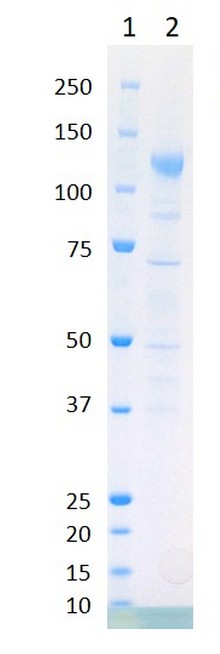Type
Recombinant protein
Description
SARS-CoV-2 Spike Glycoprotein (S2), Wuhan-Hu-1 strain.Contains N-terminus of the Spike protein amino acids 685-1211, C-terminally tagged with sheep Fc.Purified from culture supernatant by Protein G chromatography.
Source
HEK293
SDS-PAGE Gel
SDS-PAGE: Coomassie-stained SDS-PAGE showing purified SARS-CoV-2 Spike S2 protein.
- MW marker
- Spike S2 (8µg)
Formulation
Presented in Dulbecco’s phosphate buffered saline (DPBS) pH 7.4.
Reconstitution
Defrost at ambient temperature
Applications
Western blotting, ELISA, COVID-19
Shipping
On ice. Upon receipt, store the product at the temperature recommended below.
Storage/Expiration
Store protein at -80°C. Protein remains stable until the expiry date when stored at -80°C. Avoid repeated freezing/thawing cycles.
Note
This product is intended for research use only.
Research topic
Immune Response, Infection and Inflammation, COVID-19
Summary
Coronaviruses (CoVs), within the order Nidovirales, are enveloped, single-strand, positive-sense RNA viruses with a large genome of approximately 30 kbp in length. A human infecting coronavirus (viral pneumonia) initially known as 2019 novel coronavirus (2019-nCoV) was found in the fish market at the city of Wuhan, Hubei province of China in December 2019. The virus is now named severe acute respiratory syndrome coronavirus 2 (SARS-CoV-2).
SARS-CoV-2 shares an 87% identity to the 2 bat-derived severe acute respiratory syndrome 2018 SARS-CoV-2 located in Zhoushan of eastern China. SARS-CoV-2 has an analogous receptor-BD-structure to that of 2018 SARS-CoV, even though there is a.a. diversity so thus the SARS-CoV-2 might bind to ACE2 receptor protein (angiotensin-converting enzyme 2) in humans.
While bats are possibly the host of SARS-CoV-2, researchers suspect that animal from the ocean sold at the seafood market was an intermediate host. RSCU analysis proposes that the SARS-CoV-2 is a recombinant within the viral spike glycoprotein between the bat coronavirus and an unknown coronavirus.
Coronaviruses contain at least four structural proteins: Spike (S) protein, envelope (E) protein, membrane (M) protein, and nucleocapsid (N) protein.
The spike (S) glycoprotein is a type I transmembrane glycoprotein that plays an important role in mediating viral infection and is common to all HCoVs. The S proteins consist of two subunits, S1 and S2. The S1 subunit binds the cellular receptor through its receptor-binding domain (RBD), followed by conformational changes in the S2 subunit, which allows the fusion peptide to insert into the host target cell membrane. The heptad repeat 1 (HR1) region in the S2 subunit forms a homotrimeric assembly, which exposes three highly conserved hydrophobic grooves on the surface that bind heptad repeat 2 (HR2). This six-helix bundle (6-HB) core structure is formed during the fusion process and helps bring the viral and cellular membranes into close proximity for viral fusion and entry. Thus, the S protein is an important target protein for the development of specific drugs.

